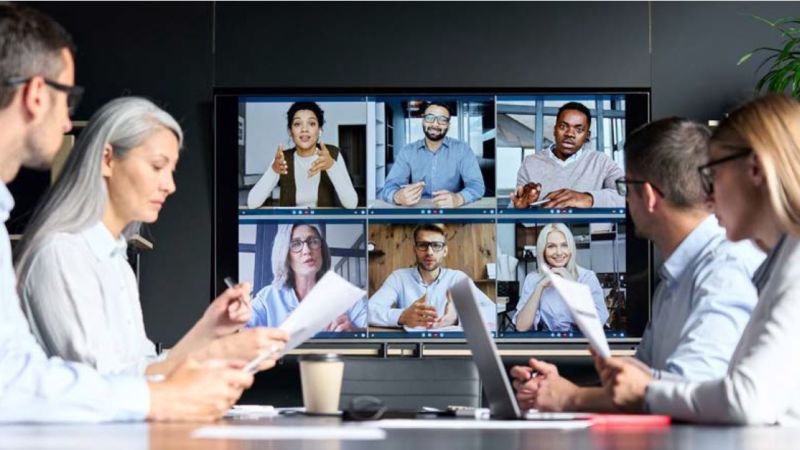In the latest article in "Practice Innovations", we learn how virtual conferencing, which flourished during the pandemic, is likely here to stay and law firms need to adapt to make it work
Despite all of your law firm’s excellent planning to prepare for the return of lawyers and staff to the office when the global pandemic lockdowns lifted, was your firm surprised by the ways in which the explosion of virtual conferencing (such as Zoom and MS Teams) impacted your legacy office environment? If so, you were far from alone.
The explosion in virtual conferencing, and its pervasive impacts on the way lawyers work, blindsided many firms because it was obscured by the work-from-home environment of the pandemic. Yet, virtual conferencing applications quickly became the fabric that tied the far-flung workforce together. It was mission critical to working with existing clients and finding new ones. And, perhaps most surprisingly, virtual court proceedings became the norm within a few months after the initial pandemic lockdowns.
For most law firms, the in-office impacts of the new virtual conferencing work styles became obvious when lawyers returned to work expecting to continue virtual conferencing in the office almost as frequently as they had done at home. And suddenly, the gaps became glaringly apparent.
Challenges in the individual office
For most firms, their physical offices were basically “mothballed,” waiting unchanged for the return of their former occupants. As lawyers brought their laptops back to their pre-pandemic offices, many suddenly felt that they had stepped backwards in time. The old flat screen monitors they had been so satisfied with were now seen as lower resolution, and often much smaller, than the big flat screens lawyers had quickly, and relatively inexpensively, purchased for home use. Many lawyers complained of eye strain and headaches, while others struggled to transition their workstyle back to smaller screens.
And what about the web camera and headset that most lawyers had acquired and come to take for granted at home? In most cases, at least initially, these were nowhere to be seen. In the office, lawyers were expected to revert to the inferior cameras and audio capabilities of their laptops. And lighting? For most, no ring light. And the locations of their desks and windows were never designed for virtual conferencing. (Indeed, lawyers often found themselves displayed on screen in virtual conferences as the dreaded “witness protection program” backlit silhouette.) Finally, what about those lawyers who had invested in green screens to project a professional backdrop and hide the “warts” in their real environment. They too were disappointed and had to revert to the backdrop capabilities of their virtual conferencing applications or strip their offices of any clutter or personal items they did not want to be seen during virtual conferences.
Fortunately, firms are beginning to address these gaps by providing webcams, microphones, and headsets, although these peripherals can also require the addition of a docking station or other port replication device to allow quick connection and disconnection of a laptop. Replacement of flat screen monitors is proving more expensive and challenging on at least two fronts: first, the office desktop real estate often limits the size and placement of a monitor; and second, supply chain disruptions can make replacements hard to come by or late in arriving.
Addressing facilities issues has also proved challenging. Do law firms need to upgrade window coverings to provide virtual-conference-friendly lighting? Can they realistically rearrange furniture effectively? Should they consider retractable green screens, and how would they mount them? Are back-of-the-chair green screens feasible? Legal office space designers report a steady influx of queries from clients about how to address these facilities challenges within the unique parameters of each office environment.
Further, open plan office spaces seemed such a good idea before the pandemic, yet upon returning to the office, firms saw that open plan spaces magnified the challenges that lawyers faced in individual offices, especially around the noise associated with virtual meetings. The quickest remedy was to provide good quality, preferably noise cancelling, headphones or some other sound-masking device, but again, this comes at a cost and availability may be limited.
And sadly, the headphone solution undermines one of the important benefits of open plan spaces — improved collaboration among personnel. It is hard to have that natural collaboration when people are buried within their headsets.
New opportunities for virtual conferencing technology
Despite the potholes described above, it seems clear that virtual conferencing will have a bright future in law firms as it becomes ever more embedded into the way lawyers work. Many firms are taking a long-term view and finding ways to redesign their approaches, such as:
Reinventing legacy conference rooms
Law firms’ traditional video conferencing rooms initially were conceived and designed as point-to-point solutions between specially designed meeting rooms with expensive, purpose-built audio visual systems. The designers never envisioned our post-pandemic world, where many of the meeting participants may not be in the designated meeting rooms, and instead are trying to connect to the video conference room equipment from remote locations through virtual conferencing applications.
Bridging this gap is proving to be more difficult, and often more expensive, than the solutions for individual offices and open plan spaces. Firms are typically working with specialized AV system providers to try to adapt or upgrade their existing systems so that they can leverage their AV investments.
Virtual proceeding conferencing rooms
Perhaps the most surprising development in the virtual conferencing landscape is the rapid pervasiveness of virtual proceedings for court trials, hearings, arbitrations, depositions, and more. Indeed, a whopping 93% of respondents to a recent survey of court officers said they were involved in conducting or participating in remote hearings in 2020, while 89% are doing so this year.
Yet there are challenges here too. Even if a firm has mastered the challenges of outfitting individual offices for a professional virtual conference experience, there are the risks of an unplanned interruption, showing the real background of a lawyer’s personal office space, and most importantly, finding that another client’s confidential information has been captured in a recorded virtual conference.
Many firms are responding to these risks by creating designated rooms for virtual proceedings that are outfitted with all the prerequisite technology and lighting. Unfortunately, these rooms are not always popular with lawyers because they require advance scheduling, and lawyers may miss the familiar environment and support resources associated with their personal offices.
Renewed interest in telepresence
Telepresence — a system debuted in 2006 by Cisco Systems that can link two physically separated, specially equipped rooms so they resemble a single conference room — features very large flat screens that project near-life size images of remote participants. These screens are typically on the opposite side of a conference table, creating the illusion that all participants are seated around the conference table and speaking in real time. DLA Piper US, for example, was among the early law firm adopters of this technology, finding it very useful in linking their network of offices.
Traditional telepresence adoption was limited in law firms, however, due to the very large investments required for specialized hardware and software, specially designed meeting rooms, and dedicated network connectivity. Many of these costs have come down over time, and with the current limitations on business travel, some organizations are giving this technology a second look.
Where do law firms go from here?
There is no doubt that virtual conferencing is here to stay. The leading application providers are competing fiercely, and new features and functions seem to appear weekly, promising to continuously improve the virtual conferencing experience of their subscribers.
The real challenge for law firms and their software providers seems to be finding effective solutions for the hybrid virtual conference, with some participants gathered in a meeting room and others connecting remotely. While the technology hurdles are not inexpensive or trivial, gaining lawyers’ acceptance of these new processes may prove to be the greatest challenge.







